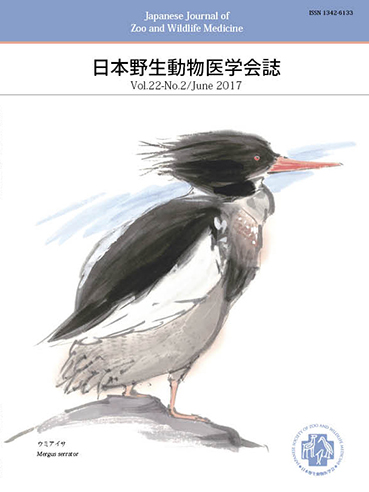
- Issue 4 Pages 55-
- Issue 3 Pages 41-
- Issue 2 Pages 25-
- Issue 1 Pages 1-
- |<
- <
- 1
- >
- >|
-
Shin-ichi NAKAMURA, Ikumi HANADA, Masayoshi KAKOGAWA, Shoki MURAKAMI ...2017 Volume 22 Issue 2 Pages 25-30
Published: June 30, 2017
Released on J-STAGE: September 01, 2017
JOURNAL FREE ACCESSWhen animals kept in zoos and aquariums die, most institutions perform necropsy, harvest and preserve the specimens for testing in-house, or deliver the specimen to other laboratories. Disease diagnosis or determination of the cause of death must be performed comprehensively based on a multitude of testing results. Therefore, selecting correct sampling methods is crucial. If appropriate methods are not followed during harvest, preservation, and transport of specimens, the testing will not produce the expected results. Selecting the appropriate harvesting methods suited to the testing objectives leads to early and accurate diagnosis, which in turn prevents animal mortality. Thus, quick and accurate diagnosis is vital for efficient animal management. For successful testing, it is important for both parties, those requesting and those performing the testing, to be mutually aware of the actual circumstances involved and communicate on a regular basis.
View full abstractDownload PDF (381K)
-
Akihiro SADO, Tomoo YOSHINO, Shinobu IKOMA, Satoshi FUJIMOTO, Mitsuh ...2017 Volume 22 Issue 2 Pages 31-36
Published: June 30, 2017
Released on J-STAGE: September 01, 2017
JOURNAL FREE ACCESSA parasitological survey of 39 individuals of wild mammals (including Vulpes vulpes, Neovison vison, Apodemus speciousus, Myodes rufocanus befordiae, Sorex unguiculatus, Apodemus argenteus, Myodes rutilus mikado and Myotis ikonnikovi) captured and/or collected in Kushiro zoo between 2014 and 2015 was performed. A total of 26 species were detected from 35 hosts, namely Alaria alata, Echinostoma sp., Echinococcus multilocularis, Spirometra erinaceieuropaei, Taenia taeniaeformis, Catenotaenia sp., Soboliphyme abei, Porrocaecum sp., Toxocara canis, Ancylostoma caninum, Syphacia emileromani, S. montana, Heterakis spumosa, Heligmonoides speciosus, Mammanidula hokkaidensis, Heligmosomum yamagutii, Rhabditis orbitalis, Haemaphysalis longicornis, Haemaphysalis spp., Ixodes sp., Laelaps jettmari, Haemogamasus japonicus, Neotrombicula microti, Androlaelaps fahrenholzi and Spinturnix sp.. Because of the high pathogenic agent such as E. multilocularis was detected, an epidemiological comment was given.
View full abstractDownload PDF (1064K)
-
Mie NAKANO, Emi YAMAGUCHI, Miki KIMOTO, Boeun CHOI, Kotaro MATSUMOTO, ...2017 Volume 22 Issue 2 Pages 37-40
Published: June 30, 2017
Released on J-STAGE: September 01, 2017
JOURNAL FREE ACCESSMultifocal nodular lesions were observed in the lungs of Eurasian red squirrel (Sciurus vulgaris orientis) and brown rat (Rattus norvegicus) caught in Tokachi district, Hokkaido. In histopathological examination, granulomatous inflammation was found in lungs of both squirrel and rat. Spherules from 250 to 350μm in diameter were surrounded by macrophages and multinucleated giant cells. Those spherules lacked obvious internal contents, and clearly indicated trilaminar structure in the cell wall. These results strongly suggest that spherules in the lungs were adiaspores. Pathological diagnosis of both cases was adiaspiromycosis caused by Emmonsia crescens.
View full abstractDownload PDF (960K)
- |<
- <
- 1
- >
- >|